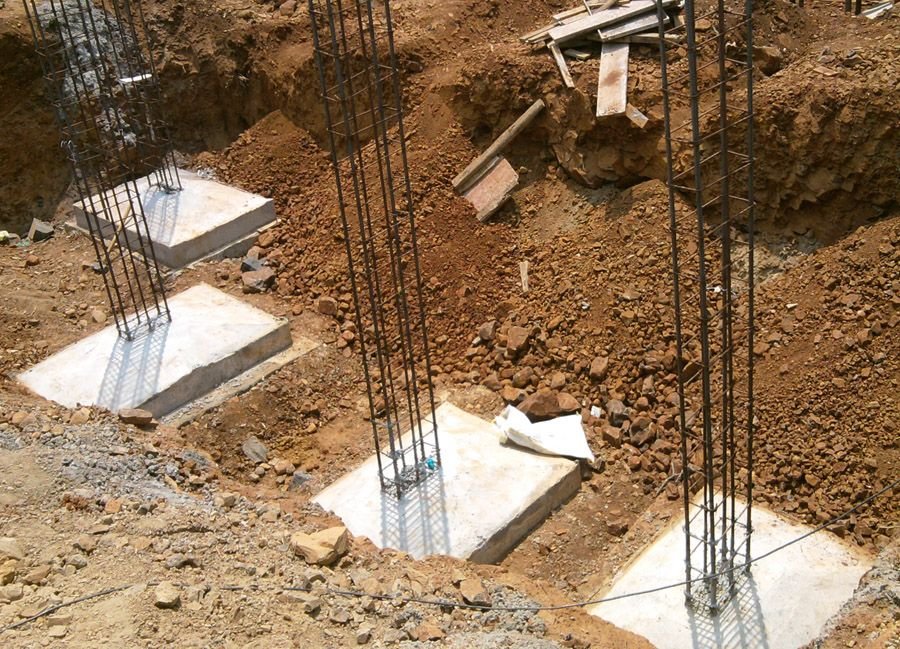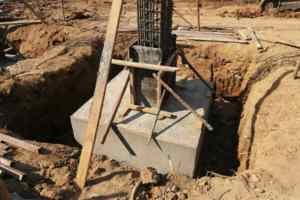Footings are structural elements of a building that serve as its foundation. They distribute the weight of the building evenly into the soil to prevent settling and ensure stability. Footings are typically made of concrete and are designed to support the weight of the building’s walls, columns, and floors. The size and depth of footings depend on various factors, including the soil type, climate, and the size and type of the building. Footings are an essential component of a building’s construction and play a critical role in ensuring its overall safety and stability.

Source: Pinterest
Footing: Role
The role of footings in construction is to transfer the weight of the building evenly into the soil, providing a stable base for the structure. Footings distribute the load of the building and prevent settling, which can cause damage to the building over time. They also help to distribute the weight of the building evenly across the soil, reducing the stress on any one point and preventing soil failure.
Footings also play a critical role in resisting lateral forces, like wind and earthquakes, which can cause a building to topple. By providing a wide base for the building, footings help to distribute these forces evenly, reducing the risk of damage.
In addition to their structural role, footings also play a critical role in protecting the building from moisture and other environmental factors that can cause damage. By placing the footings below the soil surface, they help to protect the building from groundwater, frost, and other environmental hazards.
Footing: Factors needed to be considered
There are several important factors to consider when designing and constructing footings for a building:
- Soil type and conditions: The soil type and conditions play a critical role in determining the size and depth of the footings. The soil type and conditions determine the load-bearing capacity of the soil and the stability of the building. Different soil types have varying degrees of strength and stability. As a result, the size and depth of the footings must be adjusted based on the soil type to ensure the stability of the building.
- Climate: Climate can also have a significant impact on the design of footings. For example, in areas with heavy rainfall, footings may need to be deeper to prevent settling and soil failure.
- Building size and weight: The size and weight of the building play a crucial role in determining the size and depth of the footings. Heavier buildings will require larger and deeper footings to ensure stability.
- Building type: The type of building also affects the design of footings. For example, taller buildings will require larger and deeper footings to ensure stability, while lighter structures, such as residential homes, may only require shallow footings.
- Lateral forces: Footings must be designed to resist lateral forces, such as wind and earthquakes, which can cause a building to topple. The design of the footings must take these forces into account to ensure the stability of the building.
- Building code requirements: Building codes and regulations dictate the minimum standards for footings and must be followed during design and construction. The codes set guidelines for the size, depth, and materials used in footings, and may vary based on location and the type of building.

Source: Pinterest
Footing: Types
There are several types of footings used in construction, including:
- Strip Footing: This type of footing is a narrow, rectangular shape that runs along the length of a wall. Strip footings are typically used for smaller, load-bearing walls and are usually shallow in depth.
- Spread Footing: This type of footing is wider than strip footings and is used for larger walls or columns. Spread footings can be rectangular, square, or circular in shape, and their size is determined by the weight of the building and the load-bearing capacity of the soil.
- Combined Footing: This type of footing is used when two or more columns are located close together and their individual footings would overlap. Combined footings are designed to support multiple columns, providing a wider base for the building.
- Isolated Footing: This type of footing is used for individual columns and is usually circular or rectangular in shape. Isolated footings are designed to support the weight of a single column and are usually larger and deeper than strip footings.
- Mat or Raft Footing: This type of footing is a large, continuous concrete slab that spans the entire length and width of the building. Mat footings are used to support the entire building, providing a stable base for the foundation and walls.
- Pile Footing: This type of footing is used when the soil is not strong enough to support the weight of the building. Pile footings consist of concrete or steel columns that are driven into the ground to provide additional support.
Each type of footing has its own unique design and construction requirements, and the type of footing used will depend on the specific conditions and requirements of the building.
Footing: Common problems
Foundation problems can arise in a variety of ways, but here are some of the most common ones:
- Settlement: This occurs when the soil underneath the foundation settles unevenly, causing the foundation to sink and crack.
- Heaving: This occurs when soil expands and pushes against the foundation, causing it to crack or shift.
- Shrinkage: This occurs when soil moisture decreases, causing the soil to shrink and pull away from the foundation, leading to cracks.
- Hydrostatic pressure: This occurs when water builds up in the soil around the foundation, causing it to exert pressure against the walls and lead to cracking and shifting.
- Soil erosion: This occurs when water washes away soil from around the foundation, causing it to become unstable and sink.
FAQs
Why is footing important in construction?
Footing is important because it helps distribute the weight of the building evenly, preventing settling and foundation failure.
What are the different types of footings?
The types of footing are strip footings, spread footings, and wall footings.
How deep should a footing be?
A footing should be deep enough to reach undisturbed soil, typically at least 12 inches below the frost line.
Housing News Desk is the news desk of leading online real estate portal, Housing.com. Housing News Desk focuses on a variety of topics such as real estate laws, taxes, current news, property trends, home loans, rentals, décor, green homes, home improvement, etc. The main objective of the news desk, is to cover the real estate sector from the perspective of providing information that is useful to the end-user.
Facebook: https://www.facebook.com/housing.com/
Twitter: https://twitter.com/Housing
Email: [email protected]











